.
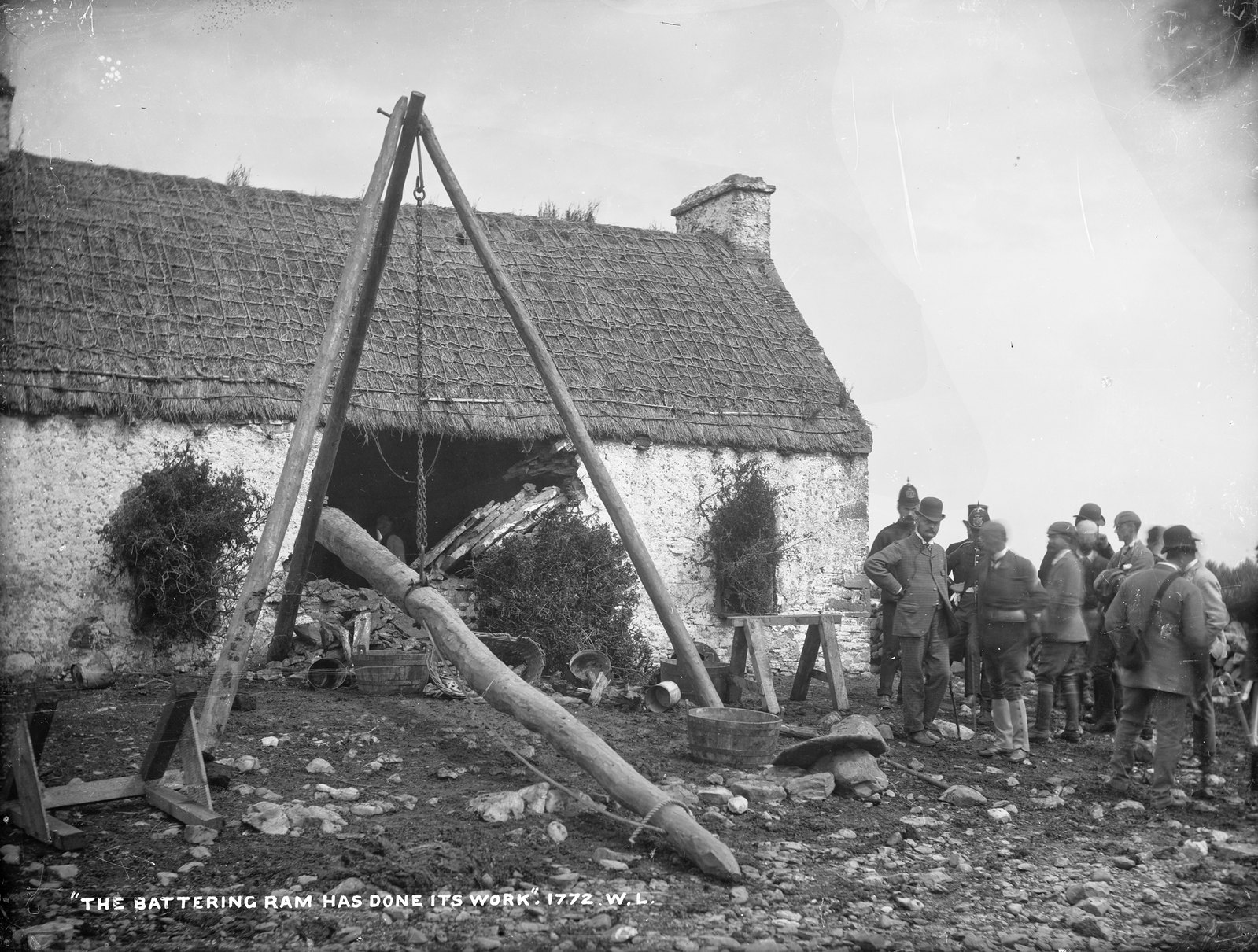
"The Battering Ram has done its work". Eviction of Thomas Birmingham, tenant of the Vandeleur Estate, near Moyasta, County Clare. photo by Robert French, c. July 1888 (Lawrence Photograph Collection, National Library of Ireland)
Adonis: "houses left their walls behind"
They found people in bags:
a person
a person
a person
and the rest had no shapes and no names.
-- Are you mad? Please
A page in a book
bombs mirror themselves inside of it
prophecies and dust-proverbs mirror themselves inside of it
cloisters mirror themselves inside of it, a carpet made of the alphabet
disentangles thread by thread
falls on the face of the city, slipping out of the needles of memory.
A murderer in the city’s air, swimming through its wound --
its wound is a fall
that trembled to its name -- to the hemorrhage of its name
and all that surrounds us --
houses left their walls behind
Adonis (b. 1930): from Desert in Selected Poems (2010), translated by Khaled Mattawa

A relative looks at the demolished house of Palestinian Bahaa Mohammed Halil Allyan in the Arab east Jerusalem neighbourhood of Jabel Mukaber on Monday: photo by Ammar Awad/Reuters. 4 January 2015
bombs mirror themselves inside of it

A Yemeni inspects his family’s apartment destroyed by airstrikes carried out by the Saudi-led coalition targeting a neighborhood in Sanaa, Yemen on Monday: photo by Yahya Arhab/EPA, 4 January 2015

Saudi-led coalition announces end of cease-fire in #Yemen (AFP pic): image via China Xinhua News @XHNews, 2 January 2015
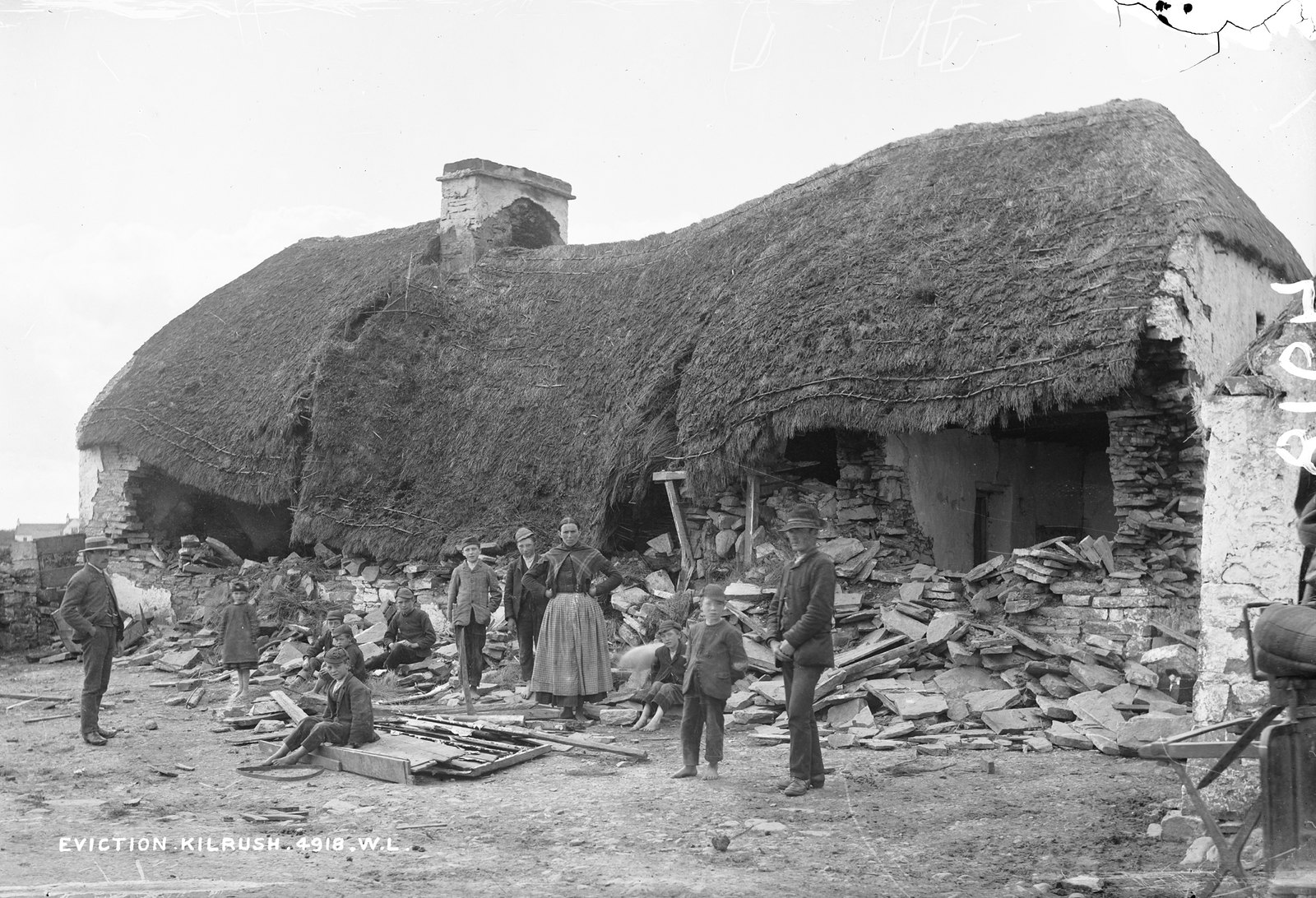
Mathias Magrath's house, Moyasta, County Clare, after destruction by the Battering Ram: photo by Robert French, 1888 (Lawrence Photograph Collection, National Library of Ireland)

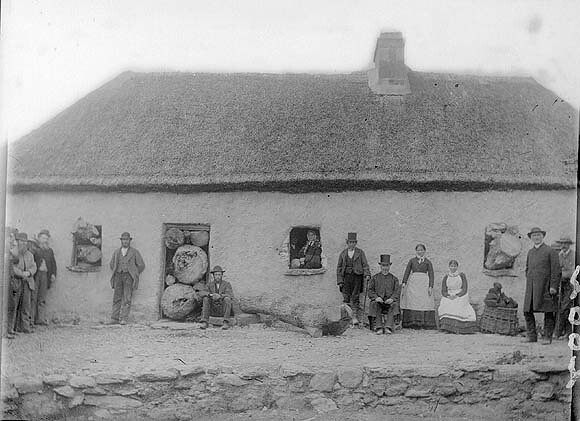
Widow Macnamara in her fortress. The home of eighty-year-old widow Margaret Macnamara, of Bodyke, County Clare, who was evicted on 2 June 1887.: photo by Henry Norman, 2 June 1887 (Eblana Photograph Collection, National Library of Ireland)
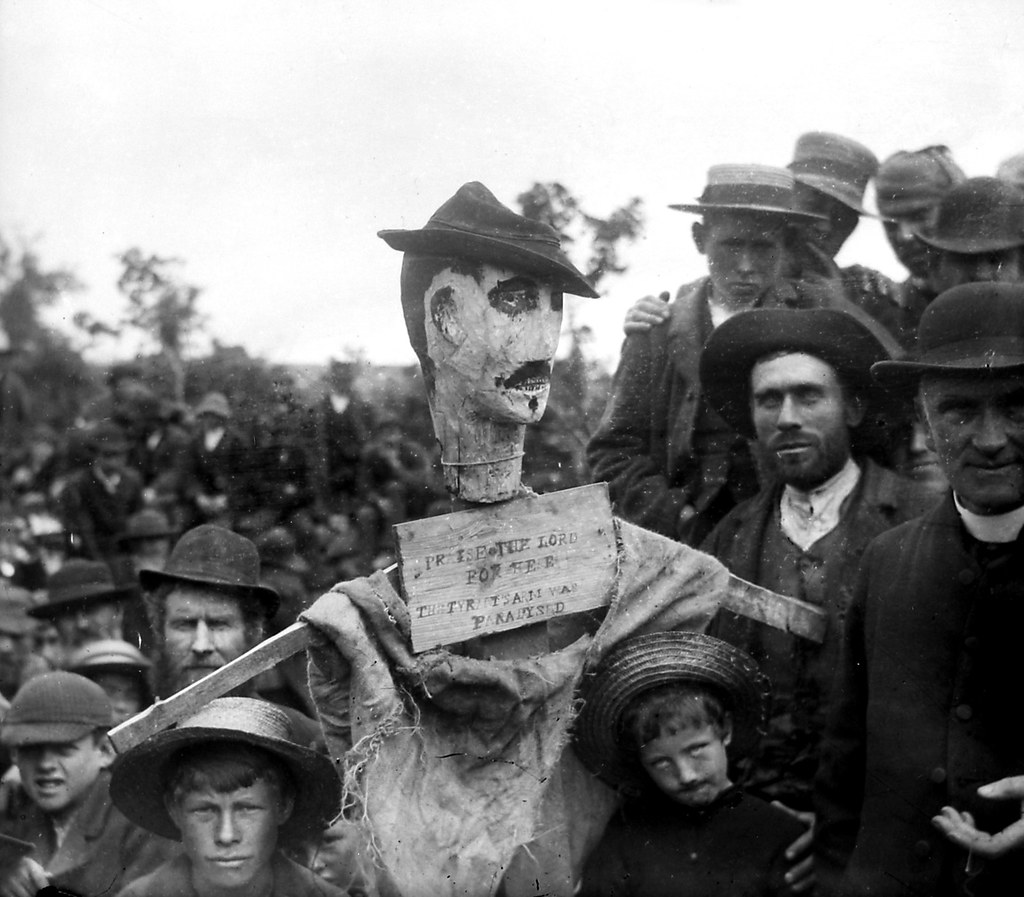
The Fire Brands, Bodyke, County Clare. The sign on the effigy reads: PRAISE THE LORD / FOR HERE / THE TYRANT'S ARM WAS / PARALYSED. Taken by Pall Mall Gazette journalist Henry Norman the day after Widow McNamara's eviction. The first sheriff, called McMahon, had turned up with a large force several days earlier but had an epileptic fit and withdrew. The tenants saw this as divine intervention and made this effigy of him.: photo by Henry Norman, Friday 5 June 1887 (Eblana Photograph Collection, National Library of Ireland)

A relative looks at the demolished house of Palestinian Bahaa Allyan in Jabel Mukaber: photo by Ammar Awad/Reuters, 4 January 2015
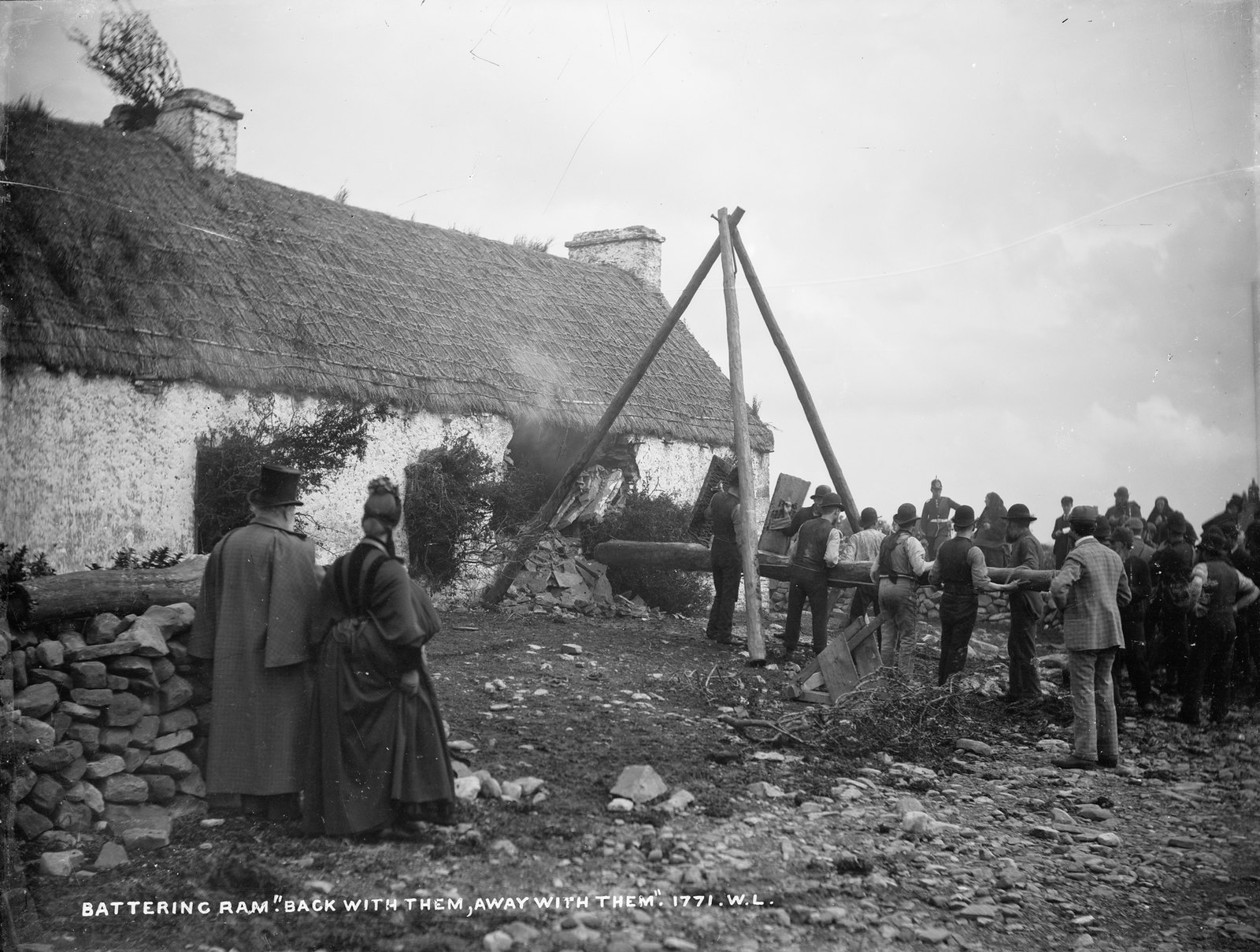
Battering Ram. "Back with them, away with them". Eviction of Thomas Birmingham, tenant of the Vandeleur Estate, near Moyasta, County Clare. photo by Robert French, 1888 (Lawrence Photograph Collection, National Library of Ireland)
A relative looks at the demolished house of Palestinian Bahaa Mohammed Halil Allyan in the Arab east Jerusalem neighbourhood of Jabel Mukaber on Monday: photo by Ammar Awad/Reuters. 4 January 2015

Widow Macnamara in her fortress. The home of eighty-year-old widow Margaret Macnamara, of Bodyke, County Clare, who was evicted on 2 June 1887.: photo by Henry Norman, 2 June 1887 (Eblana Photograph Collection, National Library of Ireland)

The Fire Brands, Bodyke, County Clare. The sign on the effigy reads: PRAISE THE LORD / FOR HERE / THE TYRANT'S ARM WAS / PARALYSED. Taken by Pall Mall Gazette journalist Henry Norman the day after Widow McNamara's eviction. The first sheriff, called McMahon, had turned up with a large force several days earlier but had an epileptic fit and withdrew. The tenants saw this as divine intervention and made this effigy of him.: photo by Henry Norman, Friday 5 June 1887 (Eblana Photograph Collection, National Library of Ireland)
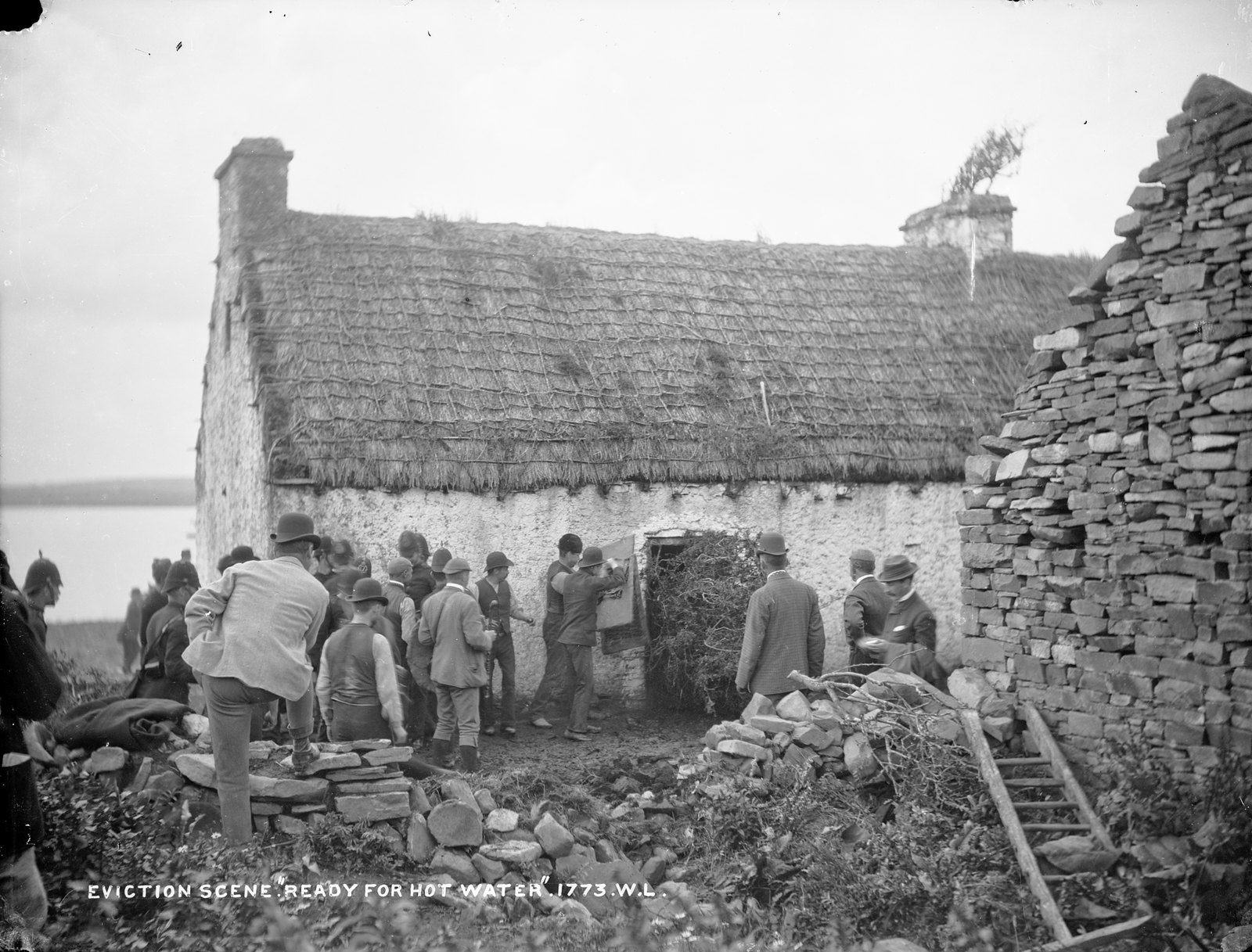
Eviction scene. "Ready for hot water". Eviction of Thomas Birmingham, tenant of the Vandeleur Estate, near Moyasta, County Clare. photo by Robert French, c. July 1888 (Lawrence Photograph Collection, National Library of Ireland)
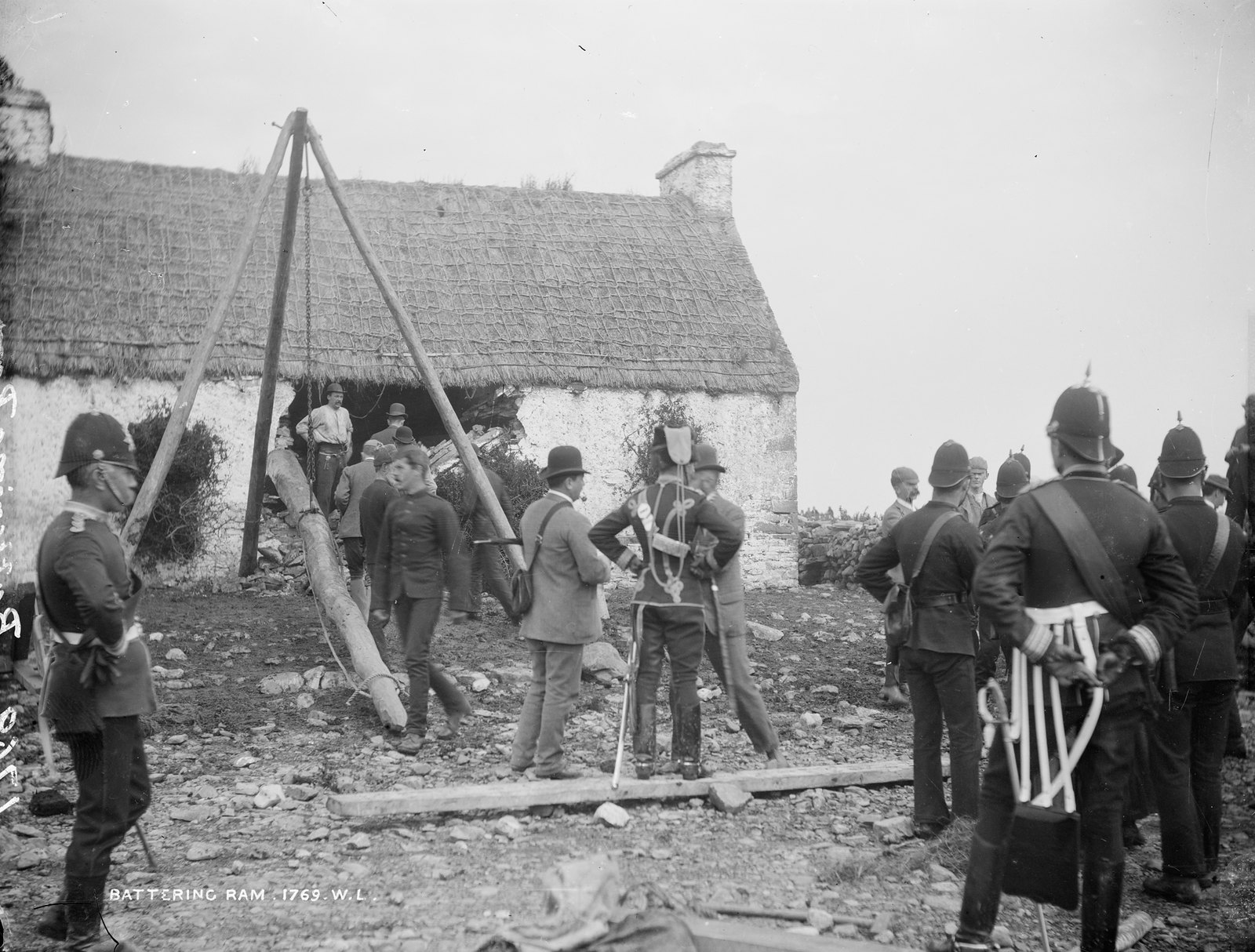
T. Birmingham's house, Moyasta, County Clare, with Battering Ram and soldiers outside: photo by Robert French, c. July 1888 (Lawrence Photograph Collection, National Library of Ireland)
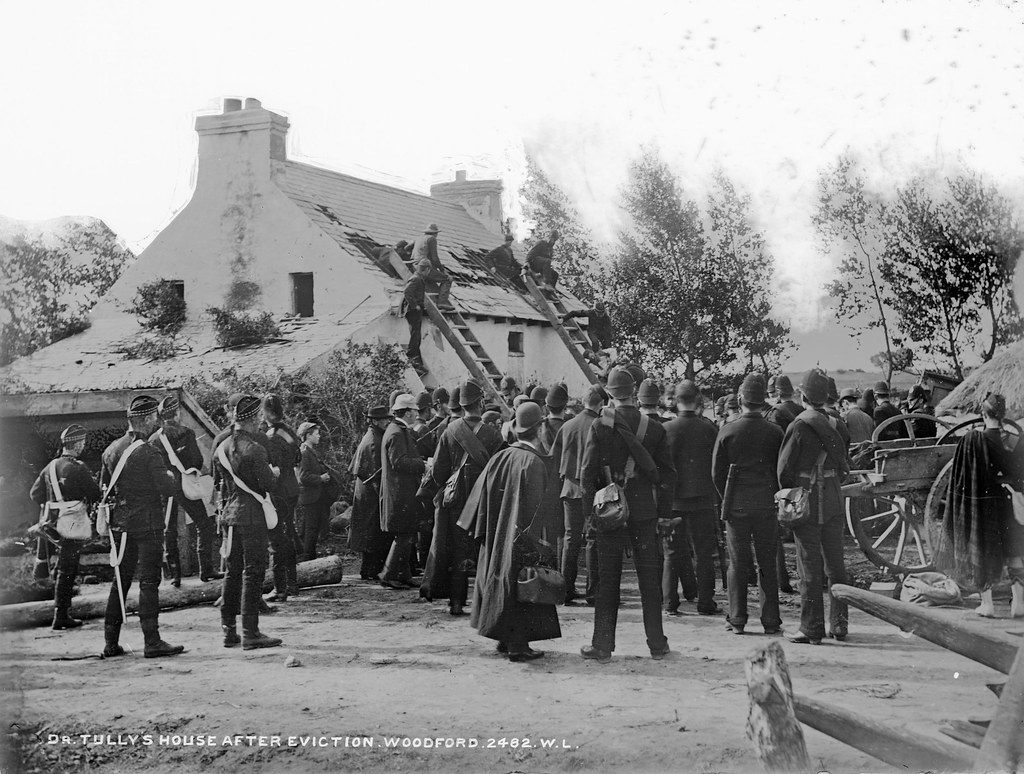
Dr Tully's House. A eviction on land of the Marquis of Clanricarde at Woodford, County Galway. Farmer and boat builder Francis Tully, known locally as "Dr Tully", was an activist for the Plan of Campaign in Galway. The Plan of Campaign was an attempt to gain lower rents through collective bargaining because prices on agricultural exports had fallen dramatically in the 1880s. Maud Gonne agitated for change by projecting images like this one onto a building in Parnell Square, Dublin: photographer unknown, 1 September 1888 (National Library of Ireland)
"The only serious attempt at resisting the execution of the law was made by "Dr." Tully, one of the leading local "agitators," to the tendency of whose harangues judicial reference was made during the investigation into the case of Mr. Wilfrid Blunt. Tully had a holding of seventeen acres at a rent of L2, 10s., the Government valuation being L4. He earned a good livelihood as a boat-builder, and he had put up a slated house on his holding. But in November 1884 he chose to stop paying the very low rent at which he held his place, and he has paid no rent since that time. As is stated in a footnote on page 153, vol. ii. of this book, a decree was granted against Tully by Judge Henn for three years' rent due in May 1887, and his equity of redemption having expired July 9, 1888, this recourse was had to the law against him."
As the leading spirit of the agitation, Tully had put a garrison into his house of twelve men and two women. He had dug a ditch around it, taken out the window-sashes, filled up the casements and the doorways with stones and trunks of trees. Portholes had been pierced under the roof, through which the defenders might thrust red-hot pikes, pitchforks, and other weapons, and empty pails of boiling water upon the assailants. A brief parley took place. Tully refused to make any offer of a settlement unless the agent would agree to reinstate all the evicted tenants, to which Mr. Tener replied that he would recognise no "combination," but was ready to deal with every tenant fairly and individually. Finally the Sheriff ordered his men to take the place. Ladders were planted, and while some of the constables, under the protection of a shield covered with zinc, a sort of Roman _testudo_, worked at removing the earthern ramparts, others nimbly climbed to the roof and began to break in from above. In their excitement the garrison helped this forward by breaking holes through the roof themselves to get at the attacking party, and in about twenty minutes the fortress was captured, and the inmates were prisoners. Two constables were burned by the red-hot pikes, the gun of another was broken to pieces by a huge stone, and a fourth was slightly wounded by a fork. One of the defenders got a sword-cut; and Tully was brought forth as one too severely wounded to walk. Upon investigation, however, the surgeon refused to certify that he was unable to undergo the ordinary imprisonment in such cases made and provided.
The collapse of the resistance at this central point was followed by a general surrender.
After the capture of Tully's house, Mr. Tener writes to me, "I found it being gutted by his family, who would have carried it away piecemeal. They had already taken away the flooring of one of the rooms." Thereupon Mr. Tener had the house pulled down, with the result of seeing a statement made in a leading Nationalist paper that he was "evicting the tenants and pulling down their houses."
"The only serious attempt at resisting the execution of the law was made by "Dr." Tully, one of the leading local "agitators," to the tendency of whose harangues judicial reference was made during the investigation into the case of Mr. Wilfrid Blunt. Tully had a holding of seventeen acres at a rent of L2, 10s., the Government valuation being L4. He earned a good livelihood as a boat-builder, and he had put up a slated house on his holding. But in November 1884 he chose to stop paying the very low rent at which he held his place, and he has paid no rent since that time. As is stated in a footnote on page 153, vol. ii. of this book, a decree was granted against Tully by Judge Henn for three years' rent due in May 1887, and his equity of redemption having expired July 9, 1888, this recourse was had to the law against him."
As the leading spirit of the agitation, Tully had put a garrison into his house of twelve men and two women. He had dug a ditch around it, taken out the window-sashes, filled up the casements and the doorways with stones and trunks of trees. Portholes had been pierced under the roof, through which the defenders might thrust red-hot pikes, pitchforks, and other weapons, and empty pails of boiling water upon the assailants. A brief parley took place. Tully refused to make any offer of a settlement unless the agent would agree to reinstate all the evicted tenants, to which Mr. Tener replied that he would recognise no "combination," but was ready to deal with every tenant fairly and individually. Finally the Sheriff ordered his men to take the place. Ladders were planted, and while some of the constables, under the protection of a shield covered with zinc, a sort of Roman _testudo_, worked at removing the earthern ramparts, others nimbly climbed to the roof and began to break in from above. In their excitement the garrison helped this forward by breaking holes through the roof themselves to get at the attacking party, and in about twenty minutes the fortress was captured, and the inmates were prisoners. Two constables were burned by the red-hot pikes, the gun of another was broken to pieces by a huge stone, and a fourth was slightly wounded by a fork. One of the defenders got a sword-cut; and Tully was brought forth as one too severely wounded to walk. Upon investigation, however, the surgeon refused to certify that he was unable to undergo the ordinary imprisonment in such cases made and provided.
The collapse of the resistance at this central point was followed by a general surrender.
After the capture of Tully's house, Mr. Tener writes to me, "I found it being gutted by his family, who would have carried it away piecemeal. They had already taken away the flooring of one of the rooms." Thereupon Mr. Tener had the house pulled down, with the result of seeing a statement made in a leading Nationalist paper that he was "evicting the tenants and pulling down their houses."
Ireland Under Coercion (2nd ed.) (2 of 2) (1888)
He wasn't really a doctor but was called this because he prescribed "leaden pills" (bullets) for greedy landlords...
(Information courtesy of an insomniac researcher on the NLI website, Jo Hedwig Teeuwisse, 2012)
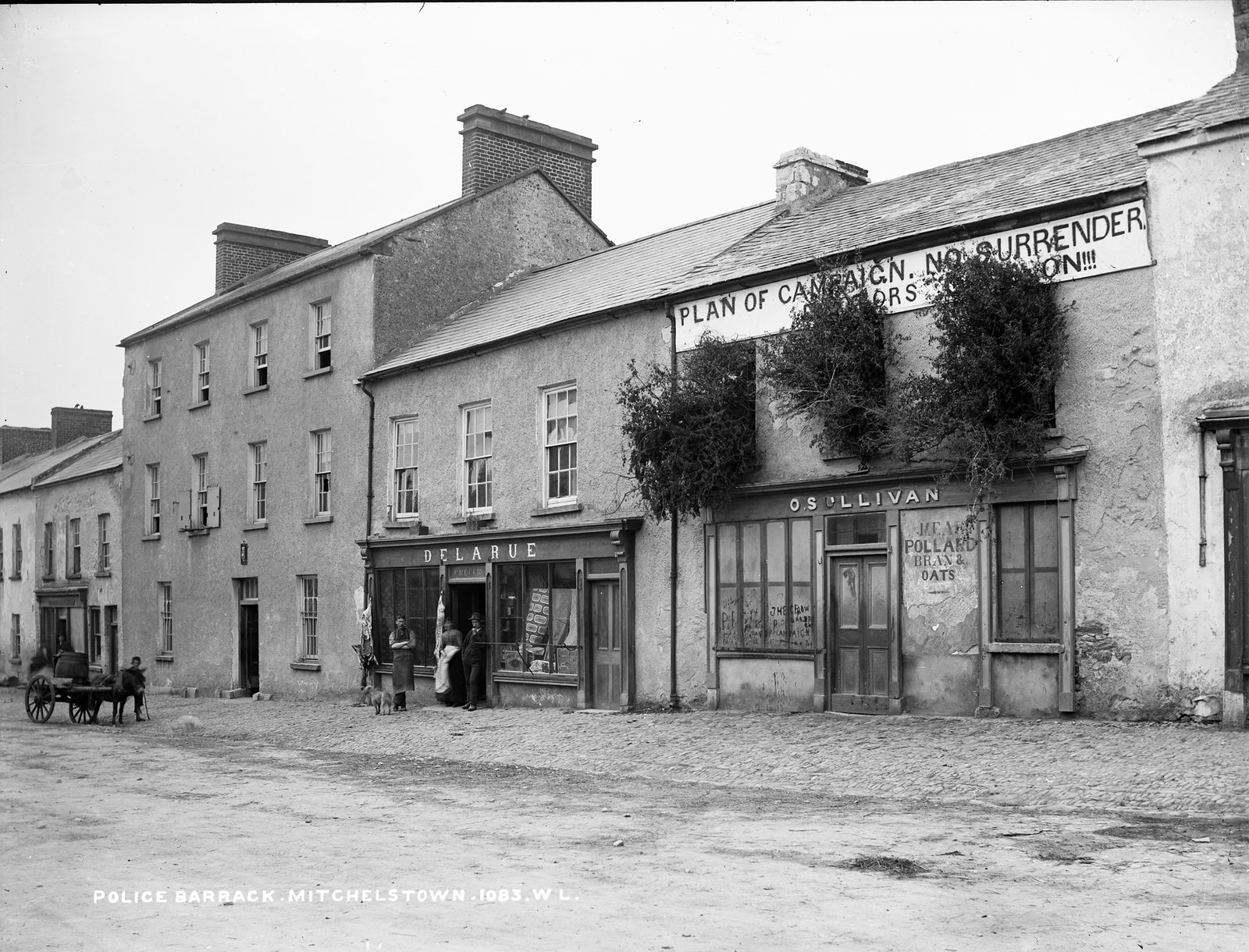
Mitchelstown Eviction Resistance at O'Sullivan's, County Cork. The plan of the campaign was an attempt to gain lower rents through collective bargaining because prices on agricultural exports had fallen dramatically in the 1880s: photographer unknown, c. June 1887 (National Library of Ireland)


